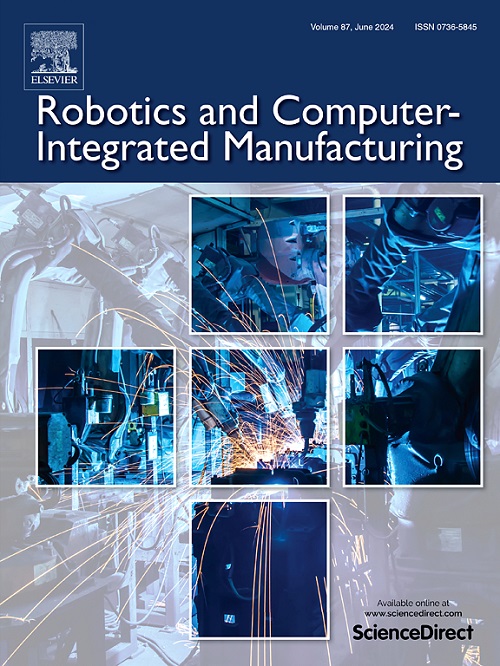基于强化学习的数字孪生机器人手臂操作:一项综合调查
IF 11.4
1区 计算机科学
Q1 COMPUTER SCIENCE, INTERDISCIPLINARY APPLICATIONS
引用次数: 0
摘要
近几十年来,机器人技术发展迅速,在各个行业的应用越来越广泛。一方面,机械臂作为机器人技术的关键部件,在众多智能工厂任务中的应用引起了学者和专家的关注。另一方面,数字孪生(DT)作为一种新兴的虚拟物理桥接技术,与仅在仿真环境中测试机械臂操作算法相比,具有显著的优势。通过促进算法在真实环境中的准确验证,DT为测试和优化算法的可行性提供了现实基础。本文讨论了基于DT的机械臂智能操作相关技术的发展现状,并对其未来发展进行了展望。更具体地说,它提供了一个新的视角来分析dt授权的机械臂智能操作技术的整个工作流程,分别从任务定义到路径规划、仿真环境和虚拟-真实通信。首先,回顾了机器人手臂的各种操作任务,如抓取、拾取、放置和组装,以及路径规划和避免碰撞的方法。其次,本文讨论了机械臂操作中各种路径规划算法的发展,重点介绍了Deep Q-learning和Proximal Policy Optimization方法等强化学习方法。第三,本文综述了Unity、MuJoCo、ROS、PyBullet等仿真环境,在这些仿真环境中实现了不同的深度学习方法。最后,分析了近年来发展起来的机械臂DT系统,包括一些新的增强现实和虚拟现实辅助应用。希望本研究能够为dt增强机械臂技术提供有价值的见解,并为进一步开展更先进的研究铺平道路。本文章由计算机程序翻译,如有差异,请以英文原文为准。
Digital twin-empowered robotic arm manipulation with reinforcement learning: A comprehensive survey
Recent decades have witnessed rapid development and increasing widespread applications of robotics across various industries. On one hand, the robotic arm, being the key component of robotics, has attracted the attention of scholars and experts with its application in quite a number of smart factory tasks. On the other hand, Digital Twin (DT), as an emerging virtual-physical bridging technique, offers significant advantages over testing robotic arm manipulation algorithms only within simulation environments. By facilitating the accurate validation of algorithms in real environments, DT provides a realistic basis for testing and optimizing their feasibility. This paper discusses the state-of-the-art of robotic arm intelligent manipulation related techniques empowered by DT and illustrates the picture for its future development. More specifically, it provides a novel perspective to analyze the entire workflow of DT-empowered robotic arm intelligent manipulation techniques, from task definition to path planning, simulation environment, and virtual-real communications, respectively. First, diverse robotic arm manipulation tasks, such as catching, picking & placing, and assembling are reviewed along with the methods of path planning and collision avoidance. Second, this paper discusses the evolution of various path planning algorithms for robotic arm manipulation, highlighting reinforcement learning methods such as Deep Q-learning and Proximal Policy Optimization approaches. Third, this paper reviews on the simulation environments containing Unity, MuJoCo, ROS, PyBullet and so on, in which different deep learning methods are implemented. Finally, recent developed robotic arm DT systems including some new Augmented Reality and Virtual Reality aided applications are analyzed. It is hoped that this study will provide valuable insights for DT-empowered robotic arm techniques and pave the way for further development of more advanced researches.
求助全文
通过发布文献求助,成功后即可免费获取论文全文。
去求助
来源期刊
CiteScore
24.10
自引率
13.50%
发文量
160
审稿时长
50 days
期刊介绍:
The journal, Robotics and Computer-Integrated Manufacturing, focuses on sharing research applications that contribute to the development of new or enhanced robotics, manufacturing technologies, and innovative manufacturing strategies that are relevant to industry. Papers that combine theory and experimental validation are preferred, while review papers on current robotics and manufacturing issues are also considered. However, papers on traditional machining processes, modeling and simulation, supply chain management, and resource optimization are generally not within the scope of the journal, as there are more appropriate journals for these topics. Similarly, papers that are overly theoretical or mathematical will be directed to other suitable journals. The journal welcomes original papers in areas such as industrial robotics, human-robot collaboration in manufacturing, cloud-based manufacturing, cyber-physical production systems, big data analytics in manufacturing, smart mechatronics, machine learning, adaptive and sustainable manufacturing, and other fields involving unique manufacturing technologies.

 求助内容:
求助内容: 应助结果提醒方式:
应助结果提醒方式:


